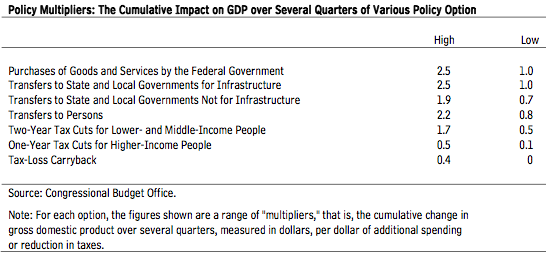The bill the Senate is expected to send to a conference committee as soon as Tuesday includes provisions -- particularly the $69.8 billion one-year "patch" on the alternative minimum tax (AMT) -- that key economists and budget specialists say are less likely to have the maximum anti-recessionary impact than direct spending provisions calling for substantial purchases by all levels of government.
The Senate has compounded the weaknesses in the bill by sharply cutting what economists agree are essential ingredients of a stimulus bill, including $40 billion in aid to states and $16 billion for school construction.
-snip
One of the biggest -- but least discussed -- of the big ticket items in the compromise Senate bill is the "patch" on the Alternative Minimum Tax. The AMT was originally designed to insure that the super-rich, capitalizing on loopholes, pay at least some federal tax. Bracket creep through inflation, however, means the AMT has begun to adversely affect upper-middle-class households with incomes from $100,000 to $300,000.
The massive AMT tax patch expenditure -- $12.4 billion more than the entire Department of Education's $59.4 billion 2007-8 budget -- received a "grade" of D-minus, the lowest grade given to any the Senate proposals, from the Brookings-Urban Institute's Tax Policy Center. "Neither timely nor targeted; makes no sense as economic stimulus," the Center declared about the provision in their Tax Stimulus Report Card.
"The AMT is a complete waste of money from a stimulus point of view," said Georgetown economist and former chief economist for the U.S. Department of Labor, Harry J. Holzer. "All the money goes to high income people who will not spend most of it."
The Congressional Budget Office (CBO) also performed calculations to indicate what kind of new spending and tax cuts would be most effective. The changes in the Senate bill to bring Senators Collins, Specter, Snowe, and Nelson on board appear to directly contradict the CBO recommendations.
The CBO calculated the multiplier effect -- "the cumulative impact on GDP
over several quarters" -- of various types of spending and tax cuts. "For example, a one-time increase in federal purchases of goods and services of $1.00 in the second quarter of this year would raise GDP by $1.00 to $2.50 in total over several quarters." In other words, the higher the multiplier, the better the stimulus effect.

-more
http://www.huffingtonpost.com/2009/02/09/the-800-billion-gamble-ec_n_165146.html